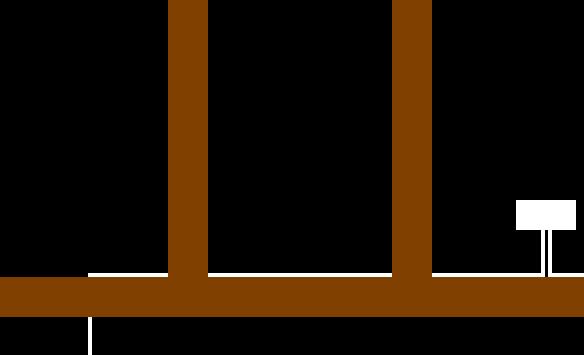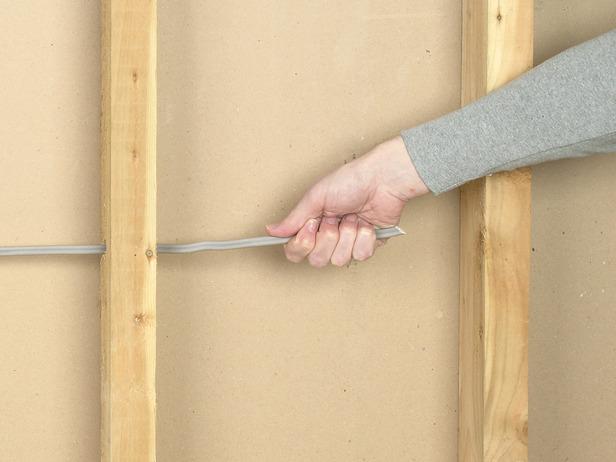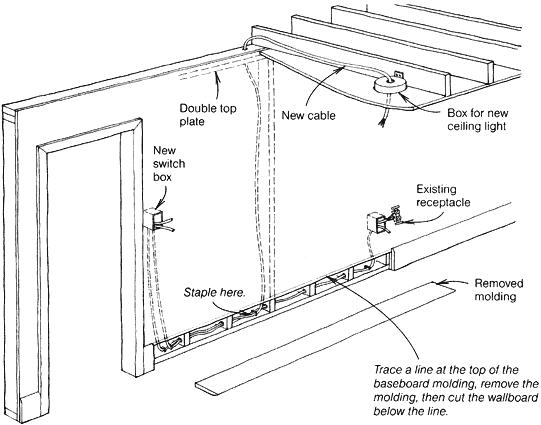You are using an out of date browser. It may not display this or other websites correctly.
You should upgrade or use an alternative browser.
You should upgrade or use an alternative browser.
Just Curious About This Method Of Running Cable In Stud Wall
- Thread starter Tozzy
- Start date
No it is not permitted to run the cable like that. You must run cables vertically or horizontally in line with your accessory. If not, no one will know it's there, and nail through it when fitting the skirting boards.
http://www.diynot.com/wiki/electrics:installation_techniques:walls
http://www.diynot.com/wiki/electrics:installation_techniques:walls
- Joined
- 27 Jan 2008
- Messages
- 27,680
- Reaction score
- 3,352
- Location
- Llanfair Caereinion, Nr Welshpool
- Country

There is a 50mm rule. If the cable is 50 mm from the outer then some of the rules don't apply. But in the main cables are run horizontal or vertical from a visible point. So both pictures would likely fall foul of the rules.
There are exceptions to every rule and to say something is wrong one has to be careful. Ali-tube cable can be run with routes not permitted with twin and earth and also without RCD protection.
There are exceptions to near every rule. Some are not really to the design ideas for example because I am an electrician I can following the rules do things in my house which for a non electrician would not comply. Clearly this is not what was intended when the rules were written.
however it does make it hard to say something should not be done without having full facts.
There are exceptions to every rule and to say something is wrong one has to be careful. Ali-tube cable can be run with routes not permitted with twin and earth and also without RCD protection.
There are exceptions to near every rule. Some are not really to the design ideas for example because I am an electrician I can following the rules do things in my house which for a non electrician would not comply. Clearly this is not what was intended when the rules were written.
however it does make it hard to say something should not be done without having full facts.
No it is not permitted to run the cable like that. You must run cables vertically or horizontally in line with your accessory. If not, no one will know it's there, and nail through it when fitting the skirting boards.
http://www.diynot.com/wiki/electrics:installation_techniques:walls[/QUOTE]
Well that's sort of what i thought until i saw this:
And this is now why I'm confusedUnless maybe this applies to a different country or for a certain accessory I don't know.
Obviously from a DIY book.
Either run the cable under the floorboards or horizontally in line with the socket.
Either run the cable under the floorboards or horizontally in line with the socket.
The cable shown going from floor to ceiling isn't right if less than 50 mm from the surface either.
DIY books on home electrics tend to be written by other DIYers or plasterers...
DIY books on home electrics tend to be written by other DIYers or plasterers...
- Joined
- 11 Jan 2004
- Messages
- 46,010
- Reaction score
- 3,568
- Country

From the use of the words "staple" and "receptacle" and the spelling of the word "molding" (not to mention the fact we'd call it skirting, plus the odd use of a ceiling fitting box right next to a joist and the cables running an odd route, I'd say it's from the US or other country using that spelling.
Why take the lighting cable all the way down the wall to go up again?
Why take the lighting cable all the way down the wall to go up again?
TO AVOID ANY CONFUSION, THIS DIAGRAM IS FOR AMERICAN WIRING REGULATIONS AND IS NOT TO BE CONFUSED WITH BRITISH STANDARDS FOR WIRING
It is not permitted to run cables - or wire accessories - as per this diagram in England and Wales. If in doubt, please ask for advice here or consult a qualified electrician.
That's OK - to go with it amazon.co.uk will happily sell you US wiring books without telling you that they don't apply here.TO AVOID ANY CONFUSION, THIS DIAGRAM IS FOR AMERICAN WIRING REGULATIONS AND IS NOT TO BE CONFUSED WITH BRITISH STANDARDS FOR WIRING
Like these for example.
http://www.amazon.co.uk/Illustrated-Residential-Wiring-Charles-Miller/dp/143542767X
http://www.amazon.co.uk/Black-Decker-Advanced-Home-Wiring/dp/1589237021
I bought one of the US wiring manuals about 10 years ago from Amazon just out of curiousity to see what there wiring methods where like.
Id gathered bits from watching This Old House on Discovery channel but it made for intresting reading
Id gathered bits from watching This Old House on Discovery channel but it made for intresting reading
Yes - for a country where it is judged to be a restaurateur's fault if a customer is injured because they drove a car with a cup of hot coffee on their lap they have a remarkably cavalier attitude to electrical safety.
A
AlexHudghton
Yes - for a country where it is judged to be a restaurateur's fault if a customer is injured because they drove a car with a cup of hot coffee on their lap they have a remarkably cavalier attitude to electrical safety.
Never let the facts get in the way of a good story
The McDonald’s Hot Coffee Case
It is the case that gave rise to the attacks on “frivolous lawsuits” in the United States. Almost everyone seems to know about it. And there’s a good chance everything you know about it is wrong.
http://www.caoc.org/index.cfm?pg=facts
Regards
Alex
There is a conflict of hazards when deciding on the temperature.
If the coffee is made and then is kept ready and waiting in a jug on a hot plate it can present a hazard of bacterial growth and subsequent illness in those who drink it. ( Minute but apparently considered significant ). So all coffee that is served that way should be kept above 60 deg C to reduce the bacterial hazard.
Similar with hot water supplies,. they should be hot enough to scald to ensure that Legionella cannot breed in the water in the tank.
If the coffee is made and then is kept ready and waiting in a jug on a hot plate it can present a hazard of bacterial growth and subsequent illness in those who drink it. ( Minute but apparently considered significant ). So all coffee that is served that way should be kept above 60 deg C to reduce the bacterial hazard.
Similar with hot water supplies,. they should be hot enough to scald to ensure that Legionella cannot breed in the water in the tank.
DIYnot Local
Staff member
If you need to find a tradesperson to get your job done, please try our local search below, or if you are doing it yourself you can find suppliers local to you.
Select the supplier or trade you require, enter your location to begin your search.
Please select a service and enter a location to continue...
Are you a trade or supplier? You can create your listing free at DIYnot Local



